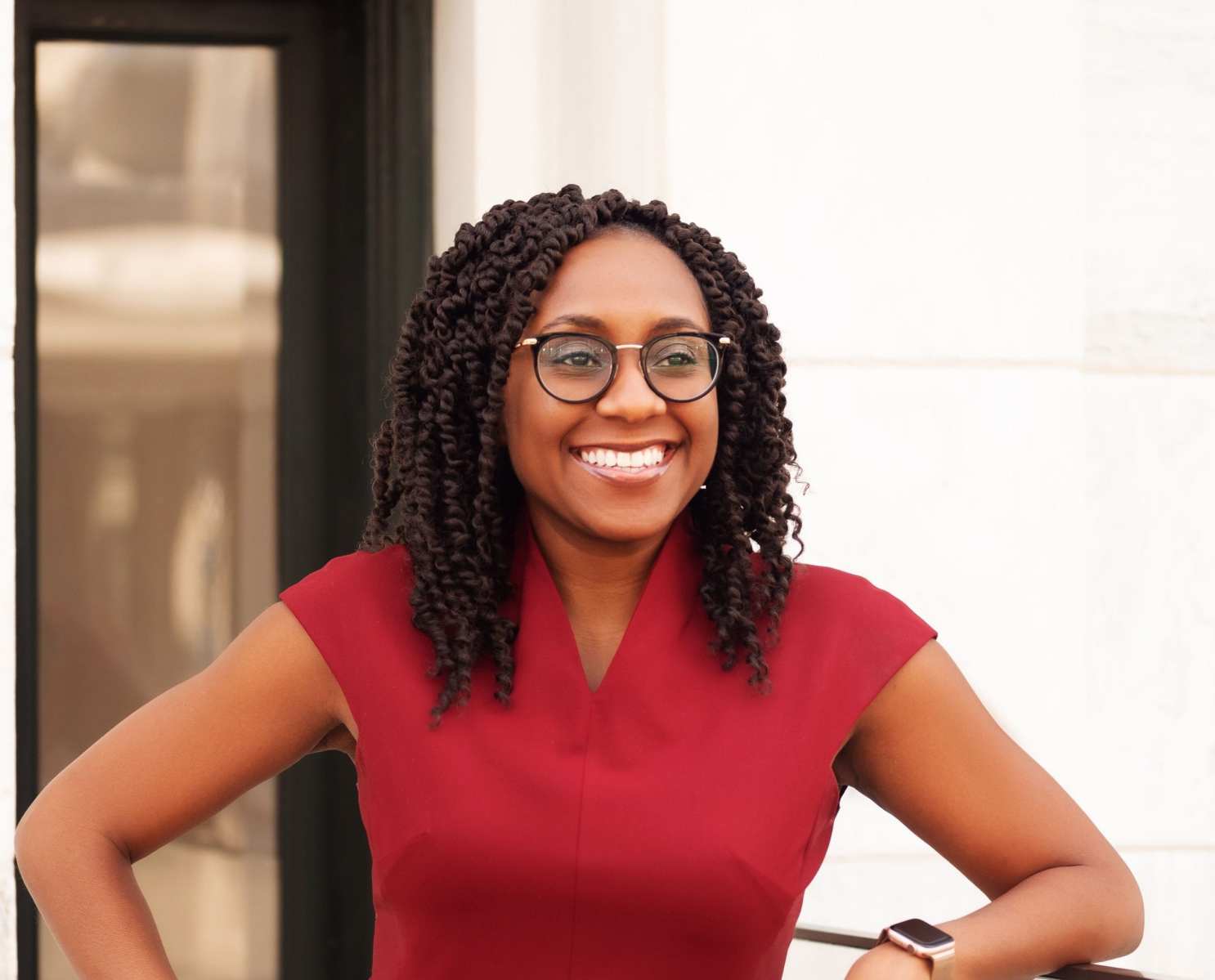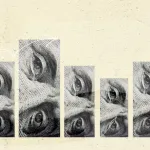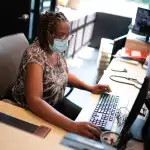In the middle of the pandemic, economist Janelle Jones coined a term that laid out a roadmap for addressing the inequality that was once again in sharp focus. It was called “Black women best.”
The merging of dual pandemics in 2020 — a public health pandemic and the pandemic of systemic racism — intensified public awareness of the intense economic burden on Black women. This past year, they consistently had among the highest unemployment rate and have been the slowest to recover jobs. Black women’s labor force participation has seen the steepest drop of any group between January and December 2020. Black women are also one of the groups most likely to be working in low-wage care fields, and therefore highly likely to be essential workers, the labor class that couldn’t quarantine and had a higher risk of exposure to the virus.
Jones’ “Black women best” framework emerged as a way to center equity in the conversation around policy. It meant that if a certain policy wasn’t benefiting Black women, the most likely group to be left behind and marginalized, then it wasn’t working to its full potential for everyone. When Black women benefited, everyone did.
The concept garnered attention, including from President Joe Biden’s administration, which asked Jones to join its ranks as chief economist at the Department of Labor. She has now been on the job for three weeks, and is the first Black woman to serve in the role.
Jones will be tasked with setting into motion the administration’s proposed worker policies — including paid sick leave, a $15 minimum wage and worker protections on the job. Biden has said he wants to be one of the most pro-labor presidents in American history, and he’s run on promises of equity.
But dismantling the complicated web of historic policies that have set people of color behind, in particular, will be a mammoth task.
Jones says she is up for it. A former economist at the Economic Policy Institute, the Bureau of Economic Analysis and the Groundwork Collaborative, a think tank focused on inequity in economic policy, Jones spoke to The 19th during Black History Month to discuss her vision for the department, and her work focusing on racial inequality, unemployment, job quality and unions.
This interview has been edited for length and clarity.
I am obliged to start this by saying “Spelman” really loudly.
I feel like people who meet me know exactly three things about me in one second: that I am from Ohio; that I went to [HBCU] Spelman [College]; [and]that I really love my mom. Those are my three leading things. It’s so annoying but I just always, always want to talk about Spelman.
Tell me about how you got the call about the job and what you did when you found out. Did you have a plan for what you wanted to do with it?
I worked at the Economic Policy Institute beforehand with Heidi Shierholz, who held this job during [the administration of President Barack] Obama, and I have an affinity for Labor, so when I knew that I might be able to get it, I was just like, ‘OK, this is worth doing’. When I got the call, someone said it to me, and I was silent for so long, they were like, ‘Did I lose you?’ I was just speechless.
I knew this was a huge opportunity to do something I’ve really wanted to do my whole career, which was help essential workers who are usually left behind. Given the time we’re in, this is the conversation, right? We’re having it all across the country, about how the economy can work better for people who are usually left behind. And so much of that lives in the Department of Labor and in this office and in this role.
I think the only [people] more excited than me, probably, is my family, who just spammed all of Facebook with announcing it that week.
Your framework, Black women best, has created a lens through which to view a long-term solution to this moment. We are in a pandemic within a pandemic — the intersection of systemic racism, COVID-19 and economic instability — all of which have uniquely hurt Black women. If you could take the temperature of this moment, do you feel the political will is there to enact a framework like this?
The specifics of Black women best I think is hard for some people. Some of the early pushback was, ‘Black women will have all the money and then everyone else will be poor.’ And that’s not the way the economy works.
We have had a lot of conversations about the way the [Paycheck Protection Program] loans left out Black-owned businesses or the way health impacts have been disparately on Black communities. There is a conversation about reaching underneath the headline number, not talking about the average.
One of the very first things that came out of the Biden-Harris administration was the racial equity executive order. That talks about not just policies and processes, but also data and what we’re thinking about, and what we consider a problem and how we study it. I think there is a real concerted effort to center some of the groups that we usually don’t center. I’m obviously speaking specifically about Black women, but I think there’s all sorts of conversations happening about how we can make sure folks are not being left behind [after] a year of economic and personal devastation.
We learned that lesson during the Great Recession. We saw that it took until 2018 for some economic indicators to fully recover for people of color. And so I think we have learned that lesson and really want to make sure we don’t do it going forward.
We can track so much of the occupational segregation for Black women to the New Deal — it’s why Black women are still overrepresented in service and care jobs, the exact fields hit hardest by COVID-19. How can the Department of Labor ease some of the wage loss and lack of labor protections in these fields that further that inequality?
President Biden has talked a lot about the caregiving economy. If we find a way to make those jobs good-paying jobs, to make sure they have good benefits, make sure the folks who own the small businesses, who work in the day care centers, are economically secure and stable, that will do wonders for Black women who are overrepresented in those jobs.
In my role, specifically, I’m thinking about: What are the policies that we’re putting out, the rules, the regulations, the way we do enforcement? How do we make sure racial equity is included in all of that? And then another big part [is] thinking about data. The Bureau of Labor Statistics is attached to the Department of Labor and if we don’t study a problem and know exactly how big it is, we will not be able to solve it.
Last year we saw the Department of Labor narrow some of the rules around who could get paid leave through the CARES Act provisions, particularly as it relates to child care. The department was instrumental in interpreting that law. How do you view the department’s role providing a framework for paid leave policies the Biden administration is expected to propose?
The care work infrastructure [and] the care work economy [are] crucial to all the other things that we want to do. Where I’m thinking about this particular issue is how it impacts parents and how it impacts educators.
I was talking to someone, just anecdotally, and he was saying that he loses at least two to three hours every single day [of work because of child care]. If we were just speaking about productivity, we would know that we’re losing it because we don’t have a system of care infrastructure in place. [But] I am someone who likes to think about all types of measures of how the economy’s working, not just productivity.
[Caregiving] is disproportionately a field that employs women and women of color — and Black women specifically. We can cover them under minimum wage and benefits and things like that, but I think we are thinking about how that interacts with all the other pieces and I think that’s a lesson that we’ve learned this past year — that we can’t separate care work from what we’re doing with other essential workers.
And particularly with that paid leave piece, right? We close to a national paid leave policy under the CARES Act, but then that became more limited as the year went on. Biden has plans to put that back in place for a longer period of time. And that’s something that’s going to fall under your jurisdiction quite a bit.
It’s always very, very wild to me the way the U.S. is behind on paid leave, and it’s like, what will it take for us to learn the lesson? And maybe it’s now. We’re not getting ahead of the rest of the countries on the planet, we really are just catching up when we talk about paid leave. I think there’s a real appetite to do it and a real case to be made. If we want to do all of these other things, this is something that we need to do to protect workers, to handle the virus, but also just to get folks back to what they need to be economically secure.
You’ve been in the job for a few weeks now. What can we expect to be the department’s focus in the coming months? Can you give us any sense for what you have in the works?
There’s a phrase that I heard before I started this job, and I was just like, that’s so extravagant. It’s drinking from the firehose. [But] that’s it. I think if you had asked me three months ago, ‘Do you know what the Department of Labor does?’ I would have said, ‘Of course.’ I can tell you after three weeks, the Department of Labor does a million things at once.
Something that I was thinking about before I came into this role, I was thinking about the next year. It will be the one year anniversary of being trapped inside of our homes. And I think that the anniversary is really a time to reflect on what has happened. We will have a year of data on who has been hurt, who is still struggling, who is mostly recovered. There’s a lot of conversation about the K-shaped recession, [where one segment of the population begins to bounce back while another segment — those working in certain industries and largely people of color — continue to suffer].
There is a huge conversation to be had in the next few months about how we restore workers, not just to where they were in January of 2020 and not, also, to where they were before the last administration, but where they were a generation ago. I’m thinking of some of the administration priorities on minimum wage, on collective bargaining, on care work. We’re thinking about full employment.
This is an opportunity to ask, how are we measuring full employment if inflation is not really increasing? Maybe we should have a different way of thinking about that. How are we measuring whether or not a program was implemented the best way? Did it reach the most targeted populations? Did it reach Black folks? Are Indigenous folks part of the process?
There are just a ton of decisions that we’re going to make in the next year as we try to restore folks’ economic well-being, and we can apply the lens of racial equity in thinking about not just immediate relief, but also long-term recovery. So I’m going to be thinking about that.






